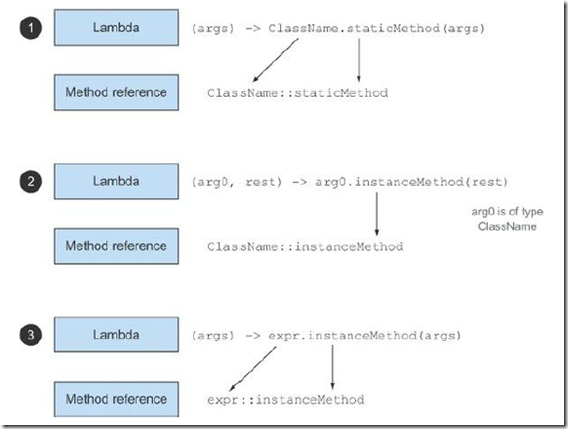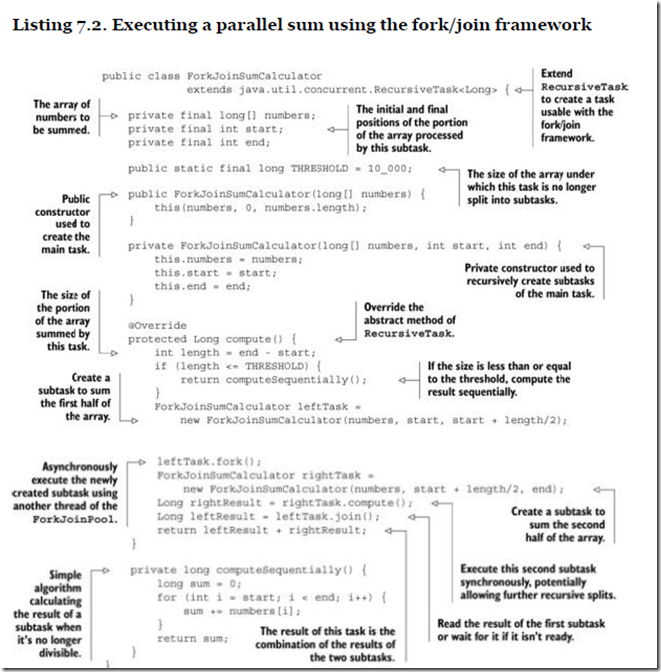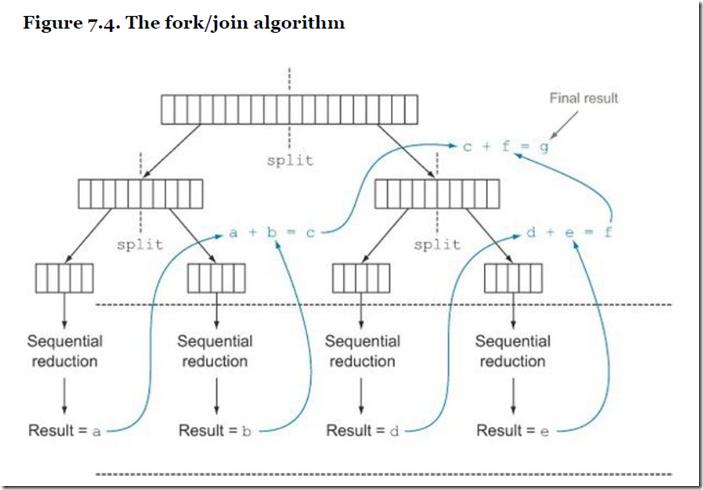解决的问题:
behavior parameterization,即可以把一段code,逻辑作为参数传入;
这样做的目的,当然为了代码抽象和重用,把变化的逻辑抽象出去;
在java中,如果要实现behavior parameterization,需要通过传入类对象的方式,你首先要声明很多类,verbose
就算你用匿名类的方式,也会大大影响代码的可读性
所以lambda,是function programing的元素,可以将一个匿名函数作为参数传入
Lambdas
A lambda expression can be understood as a concise representation of an anonymous function that can be passed around
Anonymous— We say anonymous because it doesn’t have an explicit name like a method would normally have: less to write and think about!
Function— We say function because a lambda isn’t associated with a particular class like a method is. But like a method, a lambda has a list of parameters, a body, a return type, and a possible list of exceptions that can be thrown.
Passed around— A lambda expression can be passed as argument to a method or stored in a variable.
Concise— You don’t need to write a lot of boilerplate like you do for anonymous classes.
在什么地方可以使用lamda?
So where exactly can you use lambdas? You can use a lambda expression in the context of a functional interface.
In a nutshell, a functional interface is an interface that specifies exactly one abstract method.
可以看到lambda在用法上和匿名类是等价的
Function descriptor
在java8中,有多少种functional interface,
其中function description表示functional的signature,比如Consumer,参数T,无返回值
Predicate,典型的filter场景
The java.util.function.Predicate<T> interface defines an abstract method named test that accepts an object of generic type T and returns a boolean.
Predicate<String> nonEmptyStringPredicate = (String s) -> !s.isEmpty();
List<String> nonEmpty = filter(listOfStrings, nonEmptyStringPredicate);
Consumer,消费者场景
The java.util.function.Consumer<T> interface defines an abstract method named accept that takes an object of generic type T and returns no result (void).
Function,transform场景
The java.util.function.Function<T, R> interface defines an abstract method named apply that takes an object of generic type T as input and returns an object of generic type R.
Type inference
用于编译器会做类型check和推导,所以你可以省略参数类型
Using local variables,弱版闭包
int portNumber = 1337; Runnable r = () -> System.out.println(portNumber)
看到lambda,使用临时变量
They’re called capturing lambdas
和闭包的不同是,他有限制,
Lambdas are allowed to capture (that is, to reference in their bodies) instance variables and static variables without restrictions.
But local variables have to be explicitly declared final or are effectively final.
In other words, lambda expressions can capture local variables that are assigned to them only once.
这样会报错,因为你多次修改
我的理解,其实你改不改,对于Java的实现是没有问题,反正都是在你引用的时候,产生一份copy
但是如果你修改了值,容易产生歧义,你会期望引用的值变成你改的值,其实不会
Method references
Method references let you reuse existing method definitions and pass them just like lambdas.
In some cases they appear more readable and feel more natural than using lambda expressions.
You can think of method references as syntactic sugar for lambdas that refer only to a single method because you write less to express the same thing.
一种用于更简单的表示lambda的语法糖
Recipe for constructing method references
There are three main kinds of method references:
1. A method reference to a static method (for example, the method parseInt of Integer, written Integer::parseInt)
2. A method reference to an instance method of an arbitrary type (for example, the method length of a String, written String::length)
3. A method reference to an instance method of an existing object (for example, suppose you have a local variable expensiveTransaction that holds an object of type Transaction, which supports an instance method getValue; you can write expensiveTransaction::getValue)
Constructor references
You can create a reference to an existing constructor using its name and the keyword new as follows: ClassName::new. It works similarly to a reference to a static method.
注意,Apple::new,不是调用new,这个是产生一个function interface,supplier
对于带参数的构造函数,生成的就是function
Useful methods to compose lambda expressions
Composing Comparators
Composing Predicates
Composing Functions
Streams API
To summarize, the Streams API in Java 8 lets you write code that’s
Declarative— More concise and readable
Composable— Greater flexibility
Parallelizable— Better performance
说白,就是以function programming的方式去处理collection,不需要显式的去写迭代,所以declarative
并且,可以透明的处理并行化问题
Streams vs. collections
Working with streams
To summarize, working with streams in general involves three items:
A data source (such as a collection) to perform a query on
A chain of intermediate operations that form a stream pipeline
A terminal operation that executes the stream pipeline and produces a result
Intermediate operations such as filter or sorted return another stream as the return type.
This allows the operations to be connected to form a query. What’s important is that intermediate operations don’t perform any processing until a terminal operation is invoked on the stream pipeline—they’re lazy.
Numeric streams
Mapping to a numeric stream
The most common methods you’ll use to convert a stream to a specialized version are mapToInt, mapToDouble, and mapToLong.
这样可以直接用sum
和下面的写法比较一下,
Converting back to a stream of objects
Numeric ranges
Building streams
Streams from values
Stream<String> stream = Stream.of("Java 8 ", "Lambdas ", "In ", "Action");
Stream<String> emptyStream = Stream.empty();
Streams from arrays
Streams from files
Streams from functions: creating infinite streams
Collecting data with streams
Collectors as advanced reductions
List<Transaction> transactions = transactionStream.collect(Collectors.toList());
Parallel data processing and performance
通过parallel来打开并行
sequential(),可以切换到串行
这里的并行是由fork/join来实现的
fork/join framework
The fork/join framework was designed to recursively split a parallelizable task into smaller tasks and then combine the results of each subtask to produce the overall result.
可以理解成local的map reduce
It’s an implementation of the ExecutorService interface, which distributes those subtasks to worker threads in a thread pool, called ForkJoinPool.
在java7中,我要这样写fork/join应用,比如一个简单的并行求和
注意在compute中,我们会判断阈值,如果不满足,就不断的二分,并递归的调用
然后,这样调用
public static long forkJoinSum(long n) { long[] numbers = LongStream.rangeClosed(1, n).toArray(); ForkJoinTask<Long> task = new ForkJoinSumCalculator(numbers); return new ForkJoinPool().invoke(task); }
Spliterator
这是对fork逻辑的抽象
Java 8 already provides a default Spliterator implementation for all the data structures included in its Collections Framework.
Collections now implements the interface Spliterator, which provides a method spliterator.
在Java8中,所有Collections都是实现Spliterator接口
public interface Spliterator<T> { boolean tryAdvance(Consumer<? super T> action); Spliterator<T> trySplit(); long estimateSize(); int characteristics(); }
The algorithm that splits a Stream into multiple parts is a recursive process and proceeds as shown in figure 7.6.
split的过程就是不断的调用trySplit
实现WordCount功能的Spliterator
Default methods
Interface如果发生改变,增加function,那么所有实现该interface的类都需要修改以实现新的function,这个太烦躁了;
所以在Java8,给interface加了default methods
Using Optional as a better alternative to null
大家是不是都被NullPointerException烦的不行
需要写出这样丑陋的代码
Java 8 introduces a new class called java.util.Optional<T> that’s inspired by the ideas of Haskell and Scala.
Object value = map.get("key");
写成,
Optional
也可以写成这样,
区别就是of会抛异常
option支持的操作
开始的例子,可以写成,










































